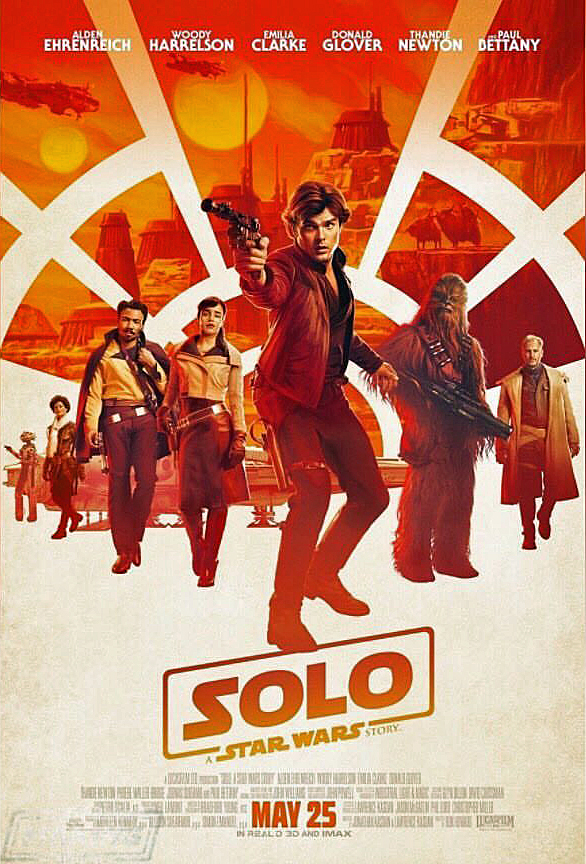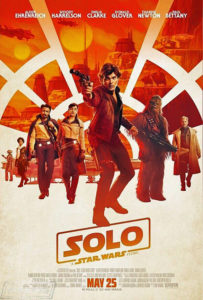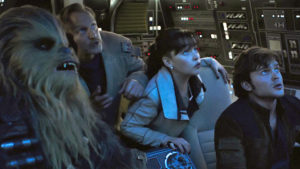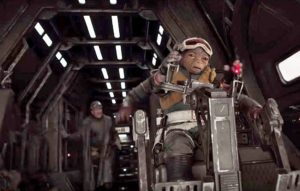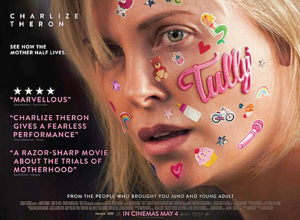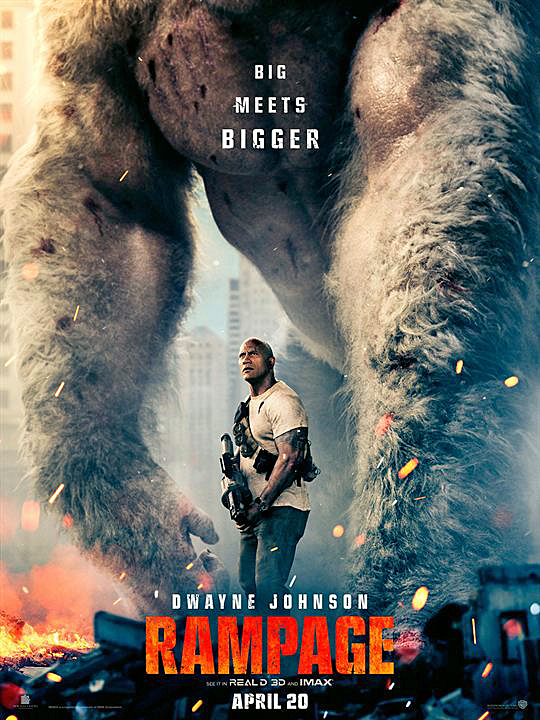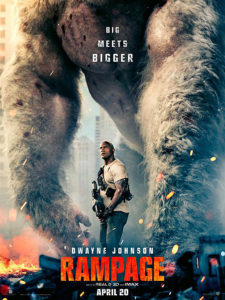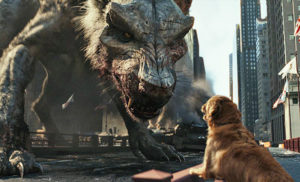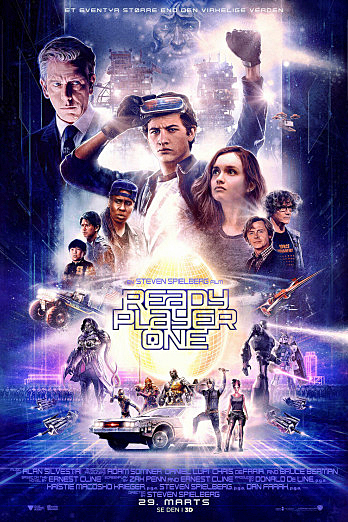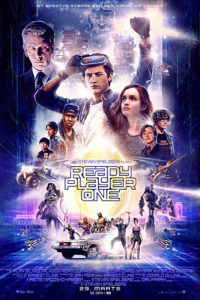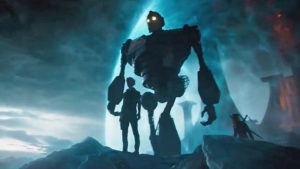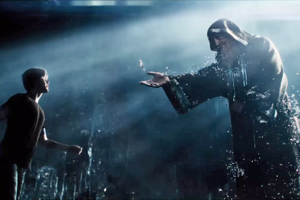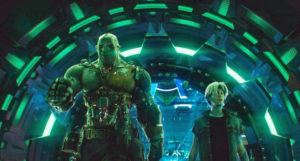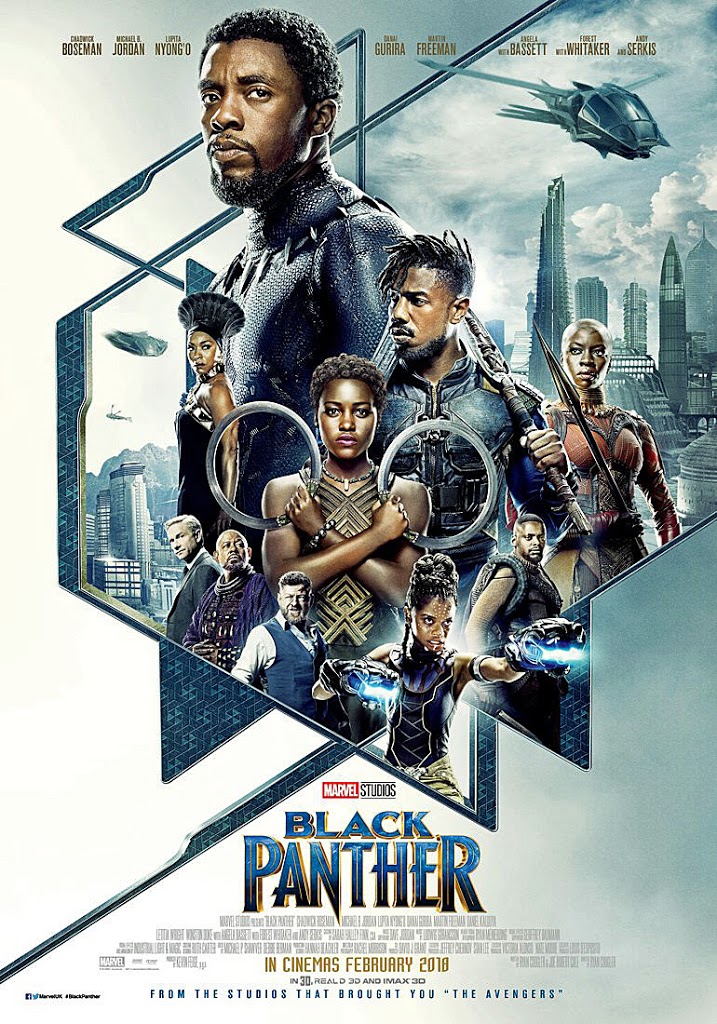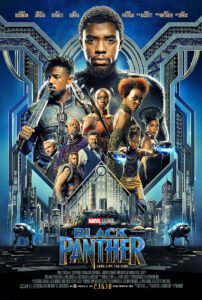Author: Steve Crum
‘Solo’ unites/reunites Han, Chewbacca in action-packed ‘Star Wars’ backstory
May 25, 2018
After 41 years (Can you believe it?!), Star Wars movie #10 warps into our space with Solo: A Star Wars Story. And it is a fun and exciting, though imperfect, addition to the Star Wars array. Solo is well worth seeing, particularly for fans. That is because only fans will pick up on all the references from the former nine flicks. Such is the built-in downside of any sequel, prequel or referential motion picture like those in the Star Wars franchise.
Solo: A Star Wars Story, directed by Ron Howard and written by established Star Wars scribes Jonathan and Lawrence Kasdan, tells a portion of the backstory of Han Solo (Alden Ehrenreich). It is set not long before Star Wars Episode IV—A New Hope. The film is not considered a prequel to mainstream Star Wars episodes, but is a called a “stand-alone installment.” However, there are allusions to future events covered by Harrison Ford’s portrayal of Han.
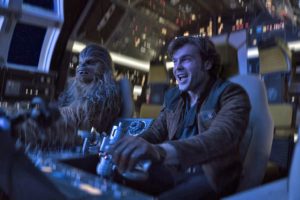 Incidentally, Ehrenreich is a very credible Han Solo without resorting to a plastic Harrison Ford impression. But like Ford’s version, the familiar Han Solo brash bravado and smart ass demeanor are clearly there.
Incidentally, Ehrenreich is a very credible Han Solo without resorting to a plastic Harrison Ford impression. But like Ford’s version, the familiar Han Solo brash bravado and smart ass demeanor are clearly there. Nearly as anticipated as seeing a young Han is seeing a younger (not young, by any means) Chewbacca, the Wookie (Joonas Suotamo). We get the scoop on how the two met and became fast compatriots. Without divulging too much, let us say that they first cross paths in a sequence hearkening to the Luke Skywalker battle versus the underground cave creature in Return of the Jedi. By this point in the 135 minute film, we have also learned of the origin of Han’s last name. (Silly me, all the time I thought Solo was his family name.)
Sandwiched between the action set pieces (a frantic land speeder chase; outmaneuvering a giant worm monster; and a dizzying monorail train battle among them), we witness Han Solo in love and lust with the stunning Qi’ra, well played by Emilia Clarke. Of course, this was pre-Princess Leia.
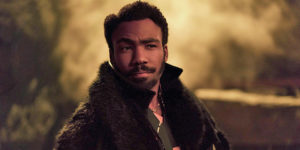 Major screen time is given to Woody Harrelson’s Tobias Beckett, who is not only Han’s mentor but a criminal with multiple allegiances. Also dubious is Donald Glover’s Lando Calrissian, the smuggler and con man originally played by Billy Dee Williams.
Major screen time is given to Woody Harrelson’s Tobias Beckett, who is not only Han’s mentor but a criminal with multiple allegiances. Also dubious is Donald Glover’s Lando Calrissian, the smuggler and con man originally played by Billy Dee Williams. Solo is filled with a roster of characters, some newly introduced (Dryden Vos, Val Beckett, Lady Proxima) as well as some surprising oldies. (One of the latter drew shrieks of awe at the screening.)
The primary plot point centers of Han and his compatriots aboard the Millennium Falcon as they execute the Kessel Run, a smuggling route in the Galactic Empire. This is Han’s bragging right he speaks of in A New Hope: “I made the Kessel Run in less than 12 parsecs.”
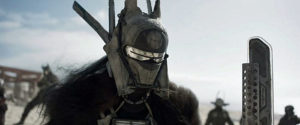 Solo’s drawback centers on dimly lit, talky sequences that slow the pace down to a near stop. Then again, the many action portions are spectacular and nail gnawing. On balance, however, Solo: A Star Wars Story is pretty grand sci-fi adventure.
Solo’s drawback centers on dimly lit, talky sequences that slow the pace down to a near stop. Then again, the many action portions are spectacular and nail gnawing. On balance, however, Solo: A Star Wars Story is pretty grand sci-fi adventure. The studio labels it a “space Western film,” which makes more than horse sense.
——————————
GRADE on an A-F Scale: B
Theron’s Oscar-worthy performance in ‘Tully’ is profound character study
May 3, 2018
Tully, not to be confused with 2016’s Sully, is not about a near air disaster. But the dramedy IS about a youngish married woman whose personal life flaunts disaster. Charlize Theron’s portrayal of the troubled spirit is nothing short of brilliant, and certainly Oscar worthy. Adding Diablo Cody’s screenplay (she also wrote 2007’s Juno) and Jason Reitman’s direction equals a trifecta supreme.
This is not discounting the impressive work of Mackenzie Davis in the title role, and the credible acting of everyone else in the small cast. That includes some fine turns by the main two child actors, Asher Miles Fallica and Lia Frankland.
Do you get the idea Tully bowled me over, critic-wise? Definitely. I even loved Rob Simonsen’s score, punctuated by covers of pop hits over the last 40+ years. “You Only Live Twice,” the James Bond/Nancy Sinatra hit, is not only well performed (by an unknown singer), but has a purposeful meaning for its inclusion. (You will figure it out when the movie ends.)
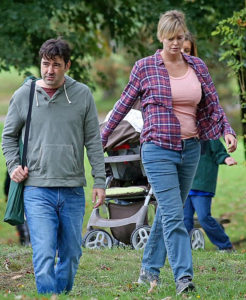 Before that occurs, there is an unfolding domestic story that begins with wife and mother Marlo (Charlize Theron) on the verge of having her third child. (The dedicated Theron gained nearly 50 pounds for the role!) We witness her daily struggle familiar to anyone who has simultaneously dealt with late stage pregnancy, getting two youngsters off to school, trying to be a good wife, and being the proverbial chief cook and bottle washer. Factor in a mostly distant, non-helpful, arrested development husband, Drew (Ron Livingston). Then there is her kindergartener son, Jonah (Fallica), who is being expelled from school due to his behavior disorders. It is overwhelming for Marlo, and uncomfortable to witness.
Before that occurs, there is an unfolding domestic story that begins with wife and mother Marlo (Charlize Theron) on the verge of having her third child. (The dedicated Theron gained nearly 50 pounds for the role!) We witness her daily struggle familiar to anyone who has simultaneously dealt with late stage pregnancy, getting two youngsters off to school, trying to be a good wife, and being the proverbial chief cook and bottle washer. Factor in a mostly distant, non-helpful, arrested development husband, Drew (Ron Livingston). Then there is her kindergartener son, Jonah (Fallica), who is being expelled from school due to his behavior disorders. It is overwhelming for Marlo, and uncomfortable to witness. The first half of the movie has a documentary look, with dominant use of the hand-held camera. But the technique segues into more traditional visuals as the story takes on a mysterious, somewhat disjointed aura. But, as we learn, there is reason for this shift.
Realize that there are many laughs throughout Tully, due to Marlo’s blatantly honest and often crude remarks. This is testament to the wit of screenwriter Cody. It reflects Marlo’s way of coping.
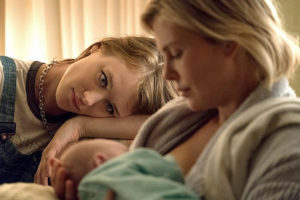 Things change for the better when Marlo’s wealthy brother (Mark Duplass) hires a night nanny, Tully, to help relieve the overnight stress of getting up to feed the baby. Tully even neatens up the house and makes treats for the kids. When the baby needs feeding in the middle of the night, Tully brings the child to Marlo at bedside, happily observing the breast feeding. If this seems uncomfortably odd, it is. Yet Marlo and Tully’s bond grows increasingly close. I have to interject that Tully is not a horror movie, even though that admission might be construed as a spoiler.
Things change for the better when Marlo’s wealthy brother (Mark Duplass) hires a night nanny, Tully, to help relieve the overnight stress of getting up to feed the baby. Tully even neatens up the house and makes treats for the kids. When the baby needs feeding in the middle of the night, Tully brings the child to Marlo at bedside, happily observing the breast feeding. If this seems uncomfortably odd, it is. Yet Marlo and Tully’s bond grows increasingly close. I have to interject that Tully is not a horror movie, even though that admission might be construed as a spoiler. “The 30’s come around the corner like a garbage truck,” laments Marlo during the third act. That telling quotation epitomizes the core spirit of Tully. During the finale, when Marlo and Tully literally race (by car and bicycle) toward the past, we realize a dangerously brittle state of depression.
The plot has a huge twist to it, a profoundly huge twist. Consider this 96 minute gem as viewing well spent.
——————————
GRADE on an A-F Scale: A
Aptly named ‘Rampage’ supplies gigantic thrills via wild animals gone wilder
April 12, 2018
Rampage delivers on its title. Big time. Described as a science fiction-monster movie, it is exactly that: a giant monster flick (featuring three baddies) that is nearly non-stop action, destruction and thrills from about 15 minutes into its 107 total. Middle schoolers, particularly, should love this one. It’s fun for older kids and adults too.
This is supported by the sounds of the youngsters near me at the screening. Their reactionary screams made me jump even more.
However, Rampage is by no means in a best film of the year category. But it IS a well honed monster flick using formula shock gimmicks that will frequently make one squirm and jump. (Beware of the giant wolf in the forest sequence.)
Brad Peyton (Cats and Dogs, San Andreas) directs a screenplay (Ryan Engle, Carlton Cuse, Ryan J. Condal and Adam Sztykiel) that is based on a classic and rather cartoonish 1986 computer game series called, appropriately, Rampage. (Warner Bros. acquired the rights when it bought Midway Games.) Peyton chose to use CGI to convert the animated game look into a realistic spectacle in which a chunk of Chicago is destroyed by the U. S. Army battling giant creatures.
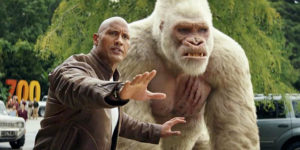 In the compelling opening sequence, set in the San Diego Zoo’s Wildlife Sanctuary, we see primatologist Davis Okoye (Dwayne Johnson once again typecast in a jungle-like setting) introducing some young colleagues to George, a rare, albino silverback gorilla. Okoye and George have obviously established great rapport, and communicate with each other by sign language.
In the compelling opening sequence, set in the San Diego Zoo’s Wildlife Sanctuary, we see primatologist Davis Okoye (Dwayne Johnson once again typecast in a jungle-like setting) introducing some young colleagues to George, a rare, albino silverback gorilla. Okoye and George have obviously established great rapport, and communicate with each other by sign language. Cut to a space station wherein an experimental drug has turned disastrous for the sole scientist aboard, who is fighting for her life against a gigantic, deranged rat. Soon, three cylinders filled with the gaseous form hurtle to earth. Two of them hit land, one in water. Wa-la, the three animals exposed to the gas soon grow much, much larger…and are driven by killer instincts. There is a grey wolf, a crocodile (which becomes Godzilla-like in appearance), and…George. Eventually, George resembles a white-furred King Kong.
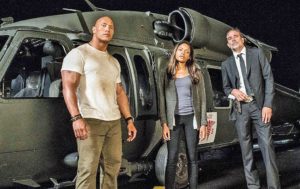 Turns out that the experimentation is the nasty work of a greedy chemical corporation, located in Chicago, which sends an electronic signal to summon the three monsters to head for Windy City. Driven by his protective camaraderie for George, Okoye teams with a genetic engineer (Naomie Harris) and the head of a private military group (Joe Manganiello), as they trek to Chicago to overpower the corporate bad guy-scientists and rescue George.
Turns out that the experimentation is the nasty work of a greedy chemical corporation, located in Chicago, which sends an electronic signal to summon the three monsters to head for Windy City. Driven by his protective camaraderie for George, Okoye teams with a genetic engineer (Naomie Harris) and the head of a private military group (Joe Manganiello), as they trek to Chicago to overpower the corporate bad guy-scientists and rescue George. Essentially turning to formula plotting, Rampage provides a hero (or three) versus some mad scientists who have unleashed monsters. We have seen this before, but it works very comfortably here.
And there are plenty of laughs along the way.
——————————
GRADE on an A-F Scale: B-
Gamers, pop culture fans should love virtual reality of Spielberg’s ‘Ready Player One’
March 28, 2018
How appropriate that Steven Spielberg’s exhausting but fun sci-fi/adventure film, Ready Player One, is opening this week. Easter is Sunday, and the movie is packed with Easter eggs. Bear with me as I explain.
Director-producer Spielberg and writers Zak Penn and Ernest Cline have used dozens of pop culture images and sounds that are strewn among the busy, mostly CGI sequences that frame Ready Player One. Many of them are shown so briefly or so nearly hidden that it would take multiple viewings to catch them all. A few of them are showcased—like The Iron Giant, King Kong, the DeLorean from Back to the Future, Chucky, and a Jurassic Park T-Rex. But you will have to look closely to spy Batman, the pod from 2001: A Space Odyssey, and more.
Inclusions of such images from movies, TV, and video games mainly from the 1980’s to present are called “Easter eggs,” since one has to sometimes search to pick them up, per se. Spielberg has said that “the movie isn’t really about nostalgia,” but he is not entirely correct. The nostalgia is firmly there, feeding a plot that opens in 2045 Columbus, Ohio.
 Teenager Wade Watts (Tye Sheridan) lives in a pretty decrepit apartment building, one among many slum castles that dot the downtown. By this time, most of the entire world lives substandard, for reasons we never know. However, the owners of the Oasis corporation corner the riches, and rule its citizens’ escapist desires. Oasis, you see, nearly monopolizes the virtual reality market with software viewed through a VR headset. People wear their headsets at work and play to escape their grim surroundings. This is a step up (or really down) from constantly using one’s cell phone.
Teenager Wade Watts (Tye Sheridan) lives in a pretty decrepit apartment building, one among many slum castles that dot the downtown. By this time, most of the entire world lives substandard, for reasons we never know. However, the owners of the Oasis corporation corner the riches, and rule its citizens’ escapist desires. Oasis, you see, nearly monopolizes the virtual reality market with software viewed through a VR headset. People wear their headsets at work and play to escape their grim surroundings. This is a step up (or really down) from constantly using one’s cell phone. 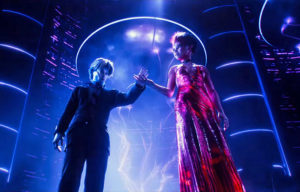 This also means that we, the audience, view most of the movie through what various characters are seeing through their headsets. Remember 1982’s Tron, wherein Jeff Bridges is pulled into a computer grid, and has to deal with life or death situations? Ready Player One employs 2018 state of the art graphics, which means vivid color and smooth, lifelike imagery. Now fantasy looks real. The effects are dazzling.
This also means that we, the audience, view most of the movie through what various characters are seeing through their headsets. Remember 1982’s Tron, wherein Jeff Bridges is pulled into a computer grid, and has to deal with life or death situations? Ready Player One employs 2018 state of the art graphics, which means vivid color and smooth, lifelike imagery. Now fantasy looks real. The effects are dazzling. 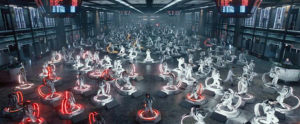 Enter more Easter eggs. This time they are well defined within the plot. The owner/founder of Oasis, James Halliday (Oscar winner Mark Rylance), has died, and willed his company to whoever finds the Easter eggs he has hidden somewhere in his vast VR grid. Anyone wanting to enter the race for the riches has to don a headset to find three keys before anyone else. Our hero Tye is on board as well as gamer Samantha (Olivia Cooke), and dozens more. Stacking the odds against them is the CEO of Innovative Online Industries, Nolan Sorrento (Ben Mendelssohn), who desperately wants to take over Oasis. There we have the central conflict. The predictable plot of typical good guy vs bad guy is handled well.
Enter more Easter eggs. This time they are well defined within the plot. The owner/founder of Oasis, James Halliday (Oscar winner Mark Rylance), has died, and willed his company to whoever finds the Easter eggs he has hidden somewhere in his vast VR grid. Anyone wanting to enter the race for the riches has to don a headset to find three keys before anyone else. Our hero Tye is on board as well as gamer Samantha (Olivia Cooke), and dozens more. Stacking the odds against them is the CEO of Innovative Online Industries, Nolan Sorrento (Ben Mendelssohn), who desperately wants to take over Oasis. There we have the central conflict. The predictable plot of typical good guy vs bad guy is handled well.Alas, there are just too many computer game references populating the 140-minute movie that are foreign to 70 year-old me. But I am not the target audience for Ready Player One. It is for the millions born years after me into a culture of computer gaming. They should get a kick out of this nearly non-stop racing movie loaded with familiar pop culture images.
Wait a minute, there was one gaming image I did recognize…the granddaddy computer game, Space Invaders.
At least that’s something.
At least that’s something.
——————————
GRADE on an A-F Scale: B
‘Black Panther’ visually stuns, but suffers style over substance shortcomings
February 16, 2018
Leaving the screening of Black Panther, I felt nearly as let down as that time in 1973 when I first saw Ross Hunter’s musical version of Lost Horizon. In both cases, the hype far outweighed the film—despite big names, glitzy sets, gorgeous costumes, and production talent galore. For sure, anticipation and pre-sale tickets have escalated to epic proportions for Black Panther. Rotten Tomatoes has already (at this writing) deemed the film near perfect, based upon 100+ critics’ praises…and this was days before the film even officially opened.
Unlike Lost Horizon, which was an immense box office dud, Black Panther is already projected to be one of the biggest superhero film opening weekends in Hollywood history.
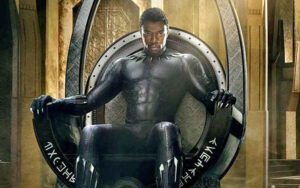 But for this Rotten Tomatoes critic, Panther turns out to be a mere puddy tat. I truly hate to say such, since I had hoped for so much more than what was delivered. The loyal fan base will no doubt think otherwise.
But for this Rotten Tomatoes critic, Panther turns out to be a mere puddy tat. I truly hate to say such, since I had hoped for so much more than what was delivered. The loyal fan base will no doubt think otherwise.While the story itself is unique in its setting, the movie plays out in conventional Marvel fashion– with nothing extraordinary or rousing in the mix this time. A major weakness of Black Panther is its numerous dimly lit scenes jammed with seemingly endless speeches. Seriously, I nearly nodded off from boredom. Director /screenwriter Ryan Coogler would have improved the pacing by trimming such sequences.
 Based on the popular Marvel comic book character, which in 1966 led the way as the first superhero of African descent in comics, Black Panther is culturally important. Admittedly, I have never read the comic book, so this movie version is my introduction. The comic book’s legion of followers had the edge on me before the film even began. They knew the backstory. I did not. That meant relying solely on the movie to grasp the mystique of T’Challa, Black Panther’s not-so-secret ID.
Based on the popular Marvel comic book character, which in 1966 led the way as the first superhero of African descent in comics, Black Panther is culturally important. Admittedly, I have never read the comic book, so this movie version is my introduction. The comic book’s legion of followers had the edge on me before the film even began. They knew the backstory. I did not. That meant relying solely on the movie to grasp the mystique of T’Challa, Black Panther’s not-so-secret ID. An opening narrative tells us that T’Challa (played by Chadwick Boseman with Ben Aflleck-like-Batman sternness) is the King of Wakanda, a technologically advanced city magically hidden in Africa. He gets his super strength by drinking a liquified herb. The elixir triggers a stylish black body suit and headpiece that identifies him as 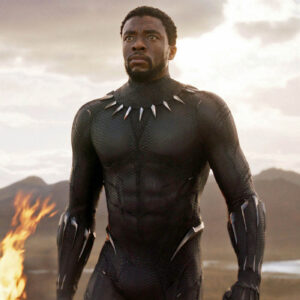 Black Panther. The drink also gives him cat-like acrobatic abilities. Those attributes are well displayed in an early-on, exciting car chase sequence. The storyline covers T’Challa’s regal lineage in Africa. He heeds his call, and assumes his royal role.
Black Panther. The drink also gives him cat-like acrobatic abilities. Those attributes are well displayed in an early-on, exciting car chase sequence. The storyline covers T’Challa’s regal lineage in Africa. He heeds his call, and assumes his royal role.
 Black Panther. The drink also gives him cat-like acrobatic abilities. Those attributes are well displayed in an early-on, exciting car chase sequence. The storyline covers T’Challa’s regal lineage in Africa. He heeds his call, and assumes his royal role.
Black Panther. The drink also gives him cat-like acrobatic abilities. Those attributes are well displayed in an early-on, exciting car chase sequence. The storyline covers T’Challa’s regal lineage in Africa. He heeds his call, and assumes his royal role. But all is not resolved. Conflicts arise from neighboring African tribes as well as smarmy arms dealer Ulysses Klaue, portrayed by the ubiquitous Andy Serkis. Then there is T’Challa’s greatest foe, Erik “Killmonger” Stevens (Michael B. Jordan), who vies to be king. Expect extended battle sequences—man vs man, tribe vs tribe. (The armored rhinos is a unique plus.) Factor in Martin Freeman in a forgettable role as Everett K. Ross, a CIA agent and sidekick to T’Challa.
Kudos to Angela Bassett as T’Challas’s Queen Mother, and Nakia (Lupita Nyong’o), leader of Wakanda’s all-female special forces squad, the Dora Milaje.
Overall, Black Panther is a comic book movie that takes itself far too seriously. In that regard, the film suffers from endless posturing, particularly by T’Challa and Killmonger. We have learned to expect such in superhero movies, but not to this extreme.
There is bound to be a sequel, and I trust it will fully live up to its hype.
——————————
GRADE on an A-F Scale: C+

